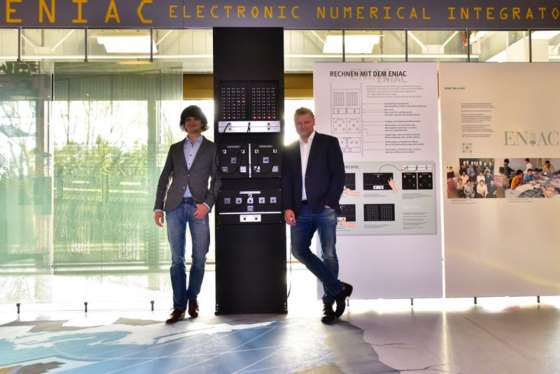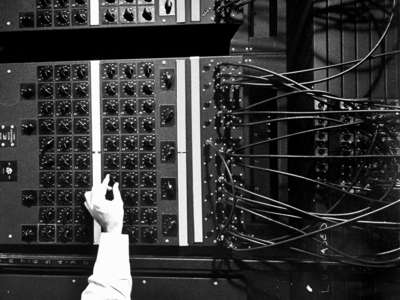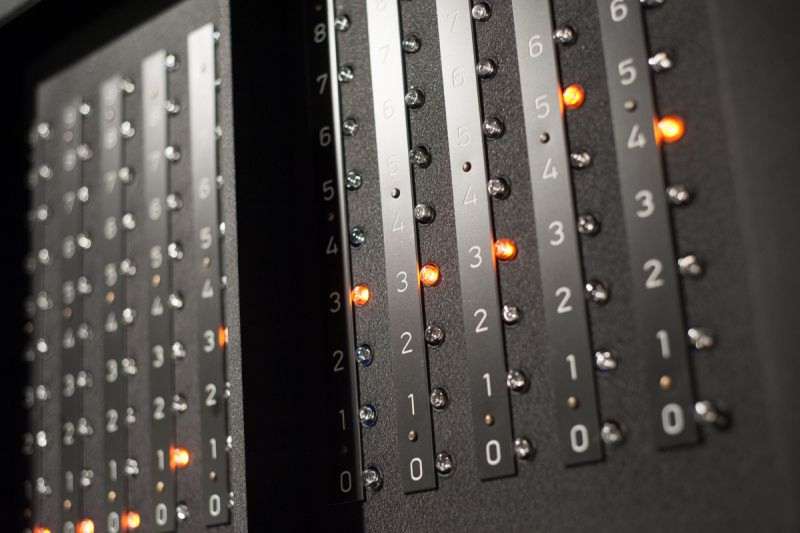| Model Of ENIAC Accumulator Wins Tony Sale Award |
| Written by Sue Gee | |||
| Sunday, 20 November 2016 | |||
|
A simplified model of the ENIAC accumulator built and exhibited by the Heinz-Nixdorf Museum in Padderborn, Germany, has won this year's Tony Sale award for computer conservation. Designer of the exhibit, Johannes Blobel, who led the implementation team and Dr Jochen Viehoff, Director Heinz Nixdorf MuseumsForum with the ENIAC reconstruction at HNF ENIAC is an iconic computer. For a long time it was considered the first electronic computer, but that honour should perhaps go to Colossus, operational in 1944 but whose very existence was kept secret until the 1970s. Unveiled at the Moore School of Engineering, University of Pennsylvania, in 1946 ENIAC was used for nearly 10 years by the US Army's Ballistic Research Laboratory to compute artillery firing tables and trajectories and the simulations needed for the H bomb. It also caught the public imagination. In a public demonstration it took only twenty seconds to work out the trajectory of a shell that took 30 seconds to reach its target. ENIAC's flashing lights and switch banks also set the look of machines in film and fiction that has hardly changed through to the present day
The original ENIAC Flashing lights are a feature of the HNF museum exhibit, a reconstruction of ENIAC's accumulator (the ‘register’ in modern terminology) which although very small in comparison to the original ENIAC serves an educational purpose of showing how programming it involved plugging wires and turning knobs requiring a physical skillset that is entirely different from that of today's programmers. It's inspiration came from was the HNF’s Ada Lovelace bicentenary celebration - the ENIAC was originally mostly programmed by women. It is in operation six days a week and is safe and robust enough to be operated unsupervised by visitors. In this video Johannes Blobel shows the accumulator in action calculating Fibonacci numbers. He points out that while speed of calculation was a feature of ENIAC this isn't replicated in order to allow an understanding of the process.
At the award ceremony in London on November 17th, chair of the judging panel, Professor Martin Campbell-Kelly said: “The HNF reconstruction captured the essence of the landmark ENIAC computer. The panel was particularly impressed at the thought and planning that went into making the reconstruction accessible to non-specialist audiences. Then the execution of the ideas produced an artifact that is robust and ideal for a hands-on museum display to demonstrate the physicality of early computer programming. Modern audiences are bound to be surprised and captivated by the reconstruction.”
Established in 2012 by the Computer Conservation Society and sponsored by Google, the Tony Sale Award recognises achievements in the growing area of computer conservation and Campbell-Kelly commented: “The judging panel has been especially pleased at the sheer variety of entries we are receiving for the Tony Sale Award for computer conservation. The ENIAC reconstruction is quite different to our previous winners: Dr David Link’s computer art installation, LoveLetters; the IBM 1401 experience by the Computer History Museum; and the virtual reconstruction of the German 1930’s Z1 mechanical computer. With such diversity and global interest, the Tony Sale Award is providing a great benchmark for the developing science and art of computer conservation.” Other entries shortlisted for the 2016 award included a restoration of a 1972 PDP-12 computer by the Rhode Island Computer Museum; the conservation of a 1980’s IBM 30684 computer in the Jim Austin collection in York, England; and the restoration of a 1960’s computer peripheral, an IBM 1403-N1 printer at the Computer History Museum in California.
More InformationRelated ArticlesAward Established for Computer Conservation
To be informed about new articles on I Programmer, sign up for our weekly newsletter, subscribe to the RSS feed and follow us on Twitter, Facebook or Linkedin.
Comments
or email your comment to: comments@i-programmer.info |
|||
| Last Updated ( Saturday, 08 June 2019 ) |




